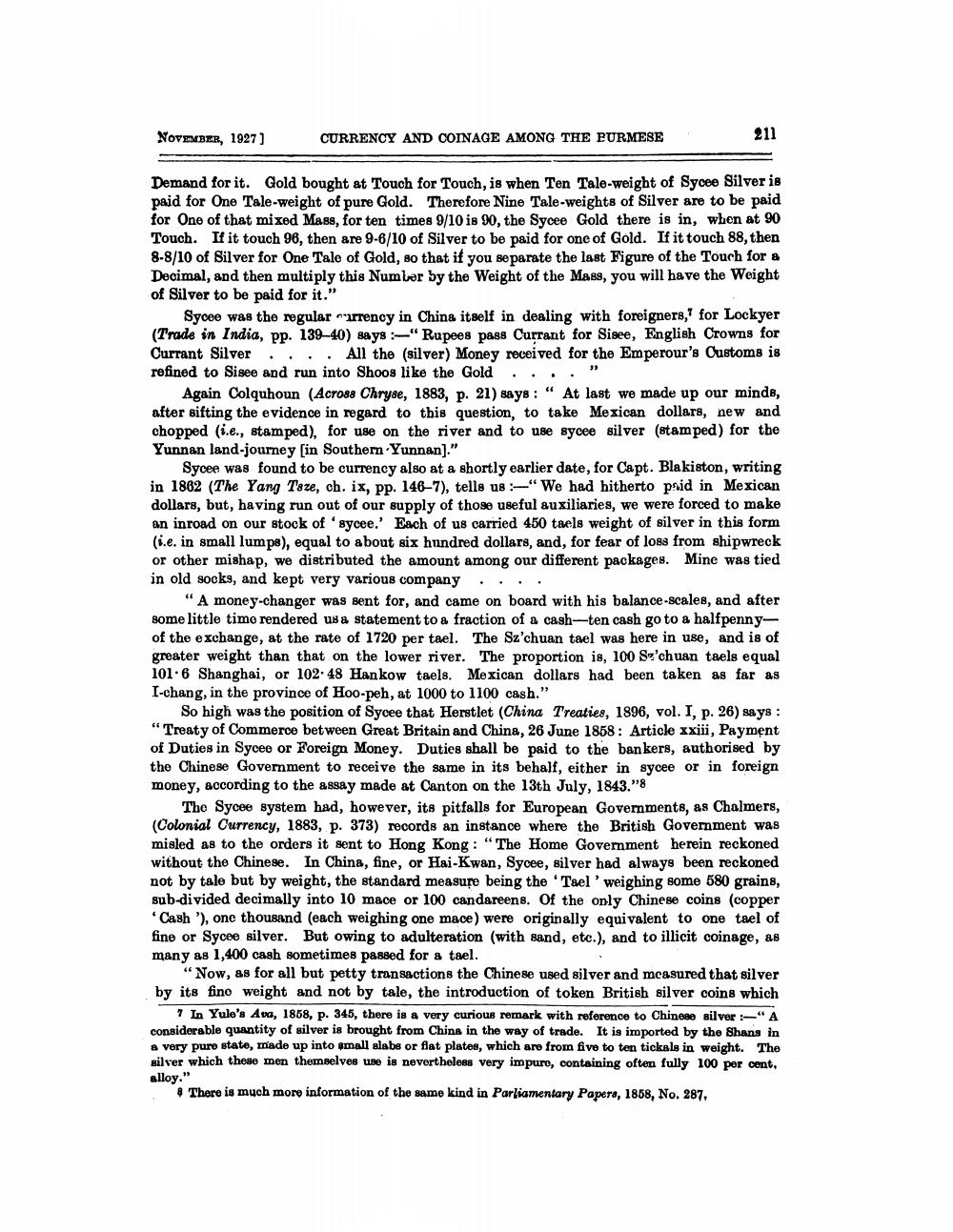________________
NOVEMBER, 1927)
CURRENCY AND COINAGE AMONG THE PURMESE
211
Demand for it. Gold bought at Touch for Touch, is when Ten Tale-weight of Sycee Silver is paid for One Tale-weight of pure Gold. Therefore Nine Tale-weights of Silver are to be paid for One of that mixed Mass, for ten times 9/10 is 90, the Sycee Gold there is in, when at 90 Touch. If it touch 96, then are 9-6/10 of Silver to be paid for one of Gold. If it touch 88, then 8-8/10 of Silver for One Talo of Gold, so that if you separate the last Figure of the Touch for a Decimal, and then multiply this Numlor by the Weight of the Mass, you will have the Weight of Silver to be paid for it."
Sycee was the regular currency in China itself in dealing with foreigners, for Lockyer (Trade in India, pp. 139–40) says : -"Rupees pass Currant for Sisee, English Crowns for Currant Silver...All the (silver) Money received for the Emperour's Customs is refined to Sisee and run into Shoos like the Gold ...."
Again Colquhoun (Across Chryse, 1883, p. 21) says: " At last we made up our minde, after sifting the evidence in regard to this question, to take Mexican dollars, new and chopped (i.e., stamped), for use on the river and to use sycee silver (stamped) for the Yunnan land-journey (in Southern Yunnan)."
Sycee was found to be currency also at a shortly earlier date, for Capt. Blakiston, writing in 1862 (The Yang Tsze, ch. ix, pp. 146–7), tells us :"We had hitherto psid in Mexican dollars, but, having run out of our supply of those useful auxiliaries, we were forced to make an inroad on our stock of 'sycee.' Each of us carried 450 taels weight of silver in this form (i.e. in small lumps), equal to about six hundred dollars, and, for fear of loss from shipwreck or other mishap, we distributed the amount among our different packages. Mine was tied in old socks, and kept very various company .. .
"A money-changer was sent for, and came on board with his balance-scales, and after some little time rendered us a statement to a fraction of a cash-ten cash go to a halfpennyof the exchange, at the rate of 1720 per tael. The Sz'chuan tael was here in use, and is of greater weight than that on the lower river. The proportion is, 100 Sz'chuan taels equal 101.6 Shanghai, or 102.48 Hankow taels. Mexican dollars had been taken as far as I-chang, in the province of Hoo-peh, at 1000 to 1100 cash."
So high was the position of Sycee that Herstlet (China Treaties, 1896, vol. I, p. 26) says: "Treaty of Commerce between Great Britain and China, 26 June 1858: Article xxiii, Payment of Duties in Sycee or Foreign Money. Duties shall be paid to the bankers, authorised by the Chinese Government to receive the same in its behalf, either in sycee or in foreign money, according to the assay made at Canton on the 13th July, 1843."8
The Sycee system had, however, its pitfalls for European Governments, as Chalmers, (Colonial Currency, 1883, p. 373) records an instance where the British Government was misled as to the orders it sent to Hong Kong: "The Home Government herein reckoned without the Chinese. In China, fine, or Hai-Kwan, Sycee, silver had always been reckoned not by tale but by weight, the standard measure being the 'Tael' weighing some 580 grains, sub-divided decimally into 10 mace or 100 candareens. Of the only Chinese coins (copper 'Cash '), one thousand (each weighing one mace) were originally equivalent to one tael of fine or Sycee silver. But owing to adulteration (with sand, etc.), and to illicit coinage, as many as 1,400 cash sometimes passed for a tael.
"Now, as for all but petty transactions the Chinese used silver and measured that silver by its fino weight and not by tale, the introduction of token British silver coins which
7 In Yule's Ava, 1868, p. 345, there is a very curious remark with reference to Chinese silver :"A considerable quantity of silver is brought from China in the way of trade. It is imported by the Shana in a very puro stato, made up into small slabs or flat plates, which are from five to ten tickals in weight. The silver which these men themselves use is nevertheless very impuro, containing often fully 100 per cent,
alloy."
8 There is much more information of the same kind in Parliamentary Papers, 1868, No. 287.




